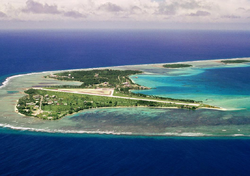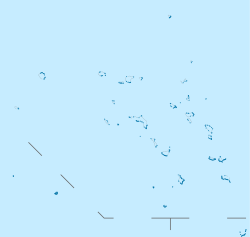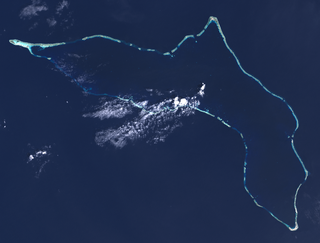
Kwajalein Atoll is part of the Republic of the Marshall Islands (RMI). The southernmost and largest island in the atoll is named Kwajalein Island, which its majority English-speaking residents often use the shortened name, Kwaj. The total land area of the atoll amounts to just over 6 square miles (16 km2). It lies in the Ralik Chain, 2,100 nautical miles southwest of Honolulu, Hawaii.

The Battle of Kwajalein was fought as part of the Pacific campaign of World War II. It took place from 31 January – 3 February 1944, on Kwajalein Atoll in the Marshall Islands. Employing the hard-learned lessons of the Battle of Tarawa, the United States launched a successful twin assault on the main islands of Kwajalein in the south and Roi-Namur in the north. The Japanese defenders put up stiff resistance, although outnumbered and under-prepared. The determined defense of Roi-Namur left only 51 survivors of an original garrison of 3,500.

Bonriki International Airport is an international airport in Kiribati, serving as the main gateway to the country. It is located in its capital, South Tarawa, which is a group of islets in the atoll of Tarawa in the Gilbert Islands, precisely on Bonriki.

1st Battalion, 23rd Marines (1/23) is one of 32 infantry battalions in the United States Marine Corps, and one of only eight battalions found in the reserve. It is located throughout Texas and Louisiana consisting of approximately 1000 Marines and Sailors. They fall under the command of the 23rd Marine Regiment and the 4th Marine Division.
Wheeler-Sack Army Airfield is a military use airport located at Fort Drum, in Jefferson County, New York, United States. It is owned by the U.S. Army.

Bucholz Army Airfield is a United States Army airfield located on Kwajalein Atoll, Marshall Islands. Its position is ideal for refueling during trans-Pacific flights, and the airport is available to civilians through Air Marshall Islands and United Airlines.

When World War II broke out the United States Naval Construction Battalions (Seabees) did not exist. The logistics of a two theater war were daunting to conceive. Rear Admiral Moreell completely understood the issues. What needed to be done was build staging bases to take the war to the enemy, across both oceans, and create the construction force to do the work. Naval Construction Battalions were first conceived at Bureau of Yards and Docks (BuDocks) in the 1930s. The onset of hostilities clarified to Radm. Moreell the need for developing advance bases to project American power. The solution: tap the vast pool of skilled labor in the U.S. Put it in uniform to build anything, anywhere under any conditions and get the Marine Corps to train it. The first volunteers came skilled. To obtain these tradesmen, military age was waived to age 50. It was later found that several past 60 had managed to get in. Men were given advanced rank/pay based upon experience making the Seabees the highest paid group in the U.S. military. The first 60 battalions had an average age of 37.
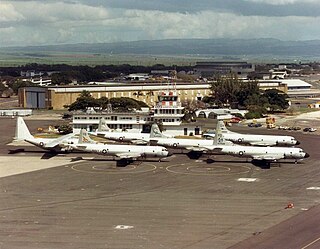
Naval Air Station Barbers Point, on O'ahu, also called John Rodgers Field, is a former United States Navy airfield closed in 1999, and renamed Kalaeloa Airport. Parts of the former air station serve as a film and television studio for the Hawaii State Film Office.
Abemama Airport is the airport serving Abemama, Kiribati. It is located on the north of the atoll, 200 meters northeast of the village of Tabiang.

Peleliu Airfield is a small airfield on Peleliu, one of the islands of Palau. It also served as an airfield during World War II.

Central Field or Iwo Jima Air Base is a former World War II airfield on Iwo Jima in the Bonin Islands, located in the Central Pacific. The Bonin Islands are part of Japan. Today, the base is the only airfield on the island, operated by the Japan Self-Defense Forces.

Angaur Airstrip is a small airstrip on Angaur, one of the islands of Palau. It also served as an airfield during World War II.

French Frigate Shoals Airport is a private use airport on Tern Island in French Frigate Shoals, a coral atoll, in Hawaii, United States. It is owned by the United States Fish and Wildlife Service, as part of the Hawaiian Islands National Wildlife Refuge.

Casco Cove Coast Guard Station was a military facility and private use airfield on Attu Island, one of the Aleutian Islands in the U.S. state of Alaska. Owned by the United States Coast Guard, Casco Cove CGS is located 1,481 miles (2,383 km) west of Anchorage, Alaska. Also known as LORAN Station Attu, the facility was closed on August 27, 2010, but the airfield remains available for emergency use.

Majuro Airfield or Naval Air Facility Majuro is a former World War II airfield on the island of Delap in the Marshall Islands.
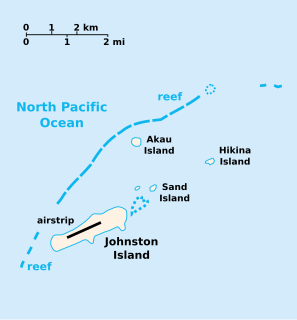
Johnston Atoll Airport is located on the Johnston Atoll in the United States Minor Outlying Islands, in the Pacific Ocean 717 nautical miles southwest of Hawaii. It was an active U.S. military facility during the 20th century, but the airport was shut down in 2005 and the runway is not maintained. Although no longer a diversion airport, it is still considered preferable to a dangerous water landing in an extreme emergency.

US Naval Advance Bases were built globally by the United States Navy during World War II to support and project U.S. naval operations world-wide. A few were built on allied soil, but most were captured enemy facilities or completely new. Advance bases provided the fleet with support to keep ships tactically available with repair and supply depots of facilities, rather than return them to CONUS. Before Japan declared war on the United States the US Navy had a single fleet sized advanced base in the Territory of Hawaii. It was Naval Station Pearl Harbor. During the war the US Navy Seabees built over 400 advance bases categorized by size. Naval bases were either Lions or Cubs while airfields were either Oaks or Acorns. Lions and Oaks were major facilities while Cubs and Acorns were minor. PT Boats typically would get a Cub and airfields with single runways were Acorns. The larger bases could do refueling and overhaul; loading of troopship and cargo ships; and preparing amphibious assault ships. Some became major repair depots. The Seabees developed auxiliary floating drydocks were able to repair battle damage and do regular maintenance in the field saving ships trans-pacific trips for repair. A few bases also were developed to be R and R for all U.S. personnel. Most Advance Bases were built by the US Navy's Seabees in Naval Construction Battalions (CBs). At the start of the war some civilian contractor were employed in construction. The Seabees in World War II built most of the airfields used by the United States Army Air Forces and United States Marine Corps, as they had the ships and cranes needed to transport the vast amount of equipment needed at the advance bases. The US Army and United States Coast Guard also operated out of many of these facilities. Seabees could build new or repair damaged runways, and with advancements in heavy bomber technology lengthen runways as needed. A few Naval Advance Bases were built for the Korean War and Vietnam War.

Naval Base Saipan or Naval Advance Base Saipan or Naval Air Base Saipan was a United States Navy Naval base built during World War II to support Pacific Ocean theater of war and the many warships and troops fighting the war. The base was on the island of Saipan in the Northern Mariana Islands. The base was part of the Pacific island hopping campaign. The base construction started after the Battle of Saipan ended on July 9, 1944. US Naval Advance Base Saipan was constructed by the Seabees Naval Mobile Construction Battalions. The base was under the Commander Naval Forces Marianas. Saipan is 12 miles (19 km) long and 5 miles (8.0 km) wide. About 70% of the island was sugarcane cultivation at the start of the base construction. At the start of the Battle of Saipan, the island's population had about 30,000 Japanese troops and about 20,000 Japanese civilians. The city of Garapan was the administrative center for the Saipan governmental district.
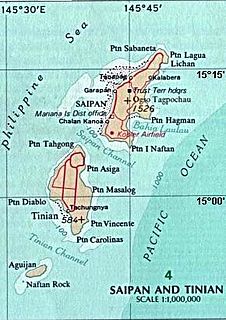
Tinian Naval Base and Naval Air Facility Tinian was a major United States Navy sea and airbase base on Tinian Island, part of the Northern Mariana Islands on the east side of the Philippine Sea in the Pacific Ocean. The Base was built during World War II to support the many bombers and aircraft fighting and patrolling in the South West Pacific theatre of war as part of the Pacific War. A number of naval facilities were built on the entire island of 101.22 km. The main port was built at the city and port of San Jose, also called Tinian Harbor. All construction was done by the Navy's Seabees Sixth Construction Brigade with minor help from the 64th Army Engineers, including the main two airports: West Field and North Field. United States Army Air Forces operated long-range bombers out of the air base built and maintained by the Seabees.

Peleliu Naval Base was a major United States Navy sea and airbase base on Peleliu island, one of sixteen states of Palau. The United States Marine Corps took the island in the Battle of Peleliu during World War II. Battle of Peleliu was a costly conflict that started September 15, 1944 and ended November 27, 1944. On September 30, 1944 Peleliu is declared occupied. The taking of Peleliu and Morotai gave the sea and air protection needed for the later invasion of the Philippines. US Navy Seabee built a number of facilities at Peleliu Naval Base.
